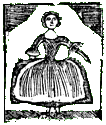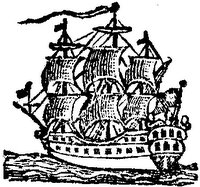Who Coined the Phrase "Till You See the Whites of Their Eyes"?
For most of the 1800s, American historians happily attributed the phrase “Don’t fire till you see the whites of their eyes” to either Israel Putnam or William Prescott, commanders at the Battle of Bunker Hill. As I discussed yesterday, there was disagreement about which of those men issued such an order, with Putnam getting an early lead but Prescott winning in the end.
Then British historian Thomas Carlyle (shown here, courtesy of NNDB.com) published his massive History of Friedrich II of Prussia, Called Frederick the Great from 1858 to 1865. And American readers couldn’t help noticing that Carlyle quoted Prussian documents about ordering soldiers not to shoot “till you see the whites of their eyes” decades before Bunker Hill.
That made authors change how they described the quotation. In Winsor’s Memorial History of Boston (1881), Edward Everett Hale wrote:
All along the American lines the order had been given which the officers remembered in the memoirs of Frederick’s wars: “Wait till you can see the whites of their eyes.”He added this explanatory footnote:
Prince Charles, when he cut through the Austrian army, in retiring from Jägendorf, gave this order to his infantry: “Silent, till you see the whites of their eyes.” This was on May 22, 1745; and this order, so sucessful that day, was remembered twelve years after at the battle of Prague, when the general Prussian order was, “By push of bayonets; no firing till you see the whites of their eyes.”Since then many reference books and websites attribute the “whites of their eyes” phrase to “Prince Charles of Prussia” at Jägendorf. He wasn’t using it in the same context as during Bunker Hill; he wanted his men to sneak through a larger Austrian force, so they shouldn’t attract attention by, say, shooting off their guns. But the clear implication is that he deserves credit for the coinage. Additionally, the citation reminds us not to simply accept our American tradition about Putnam or Prescott coining the phrase.
That’s where I thought the story ended. You know: the received version, and the slightly more interesting, less flattering reality. And then I started to look into the sources. Ironically, I found that all references to Prince Charles of Prussia at Jägendorf are a received version, too. They reproduce errors by Hale (or whomever he relied on):
- The small town was Jägerndorf, with an additional R.
- Carlyle called the Prussian commander “Margraf Karl”; the title of margraf or margrave should be translated as marquess, not prince.
- Carlyle actually quoted a “whites of their eyes” command even earlier in his book, in discussing the Battle of Mollwitz in 1741. But he didn’t credit a particular commander, and he didn’t cite a source, as in his later two references, so in this case Carlyle himself might have written too exuberantly.
I therefore searched for the phrase “white(s) of the(ir) eye(s)” in newspapers and other material printed in colonial America. I figured it might have shown up in reports from Europe or articles about how great Frederick the Great really was. But I couldn’t find a single example.
It’s possible that “whites of their eyes” was printed in English books and magazines, which were then shipped to America and read by military-minded gentlemen. It’s also possible that the Prussian phrase circulated among British officers posted to North America; both Putnam and Prescott were officers in the French and Indian War, and Putnam was particularly close to a set of British counterparts.
But it’s also possible that:
- Putnam, or another American at Bunker Hill, came up with the phrase on his own.
- Mason Weems put the phrase into Putnam’s mouth in his Life of Washington, and it stuck.









